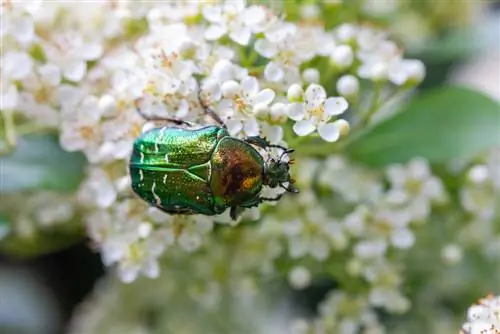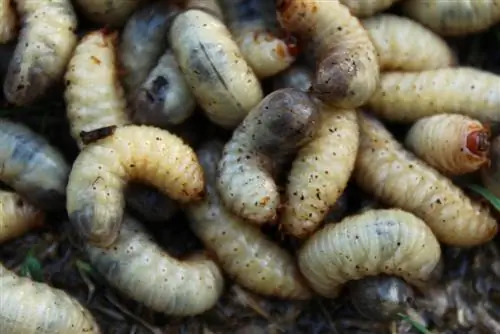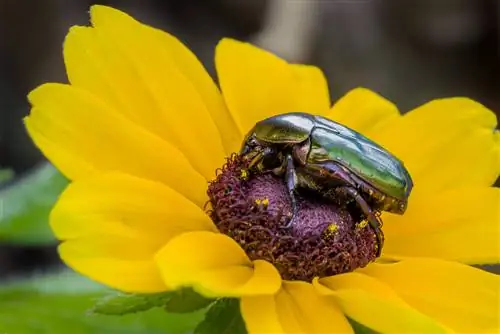- Author admin [email protected].
- Public 2023-12-16 16:46.
- Last modified 2025-06-01 06:02.
With its greenish-gold shimmering dress, the rose beetle (Cetonia aurata) is one of the most beautiful garden visitors. While the adult animals primarily visit the flowers of roses and other plants, the extremely useful grubs can be found in the compost.
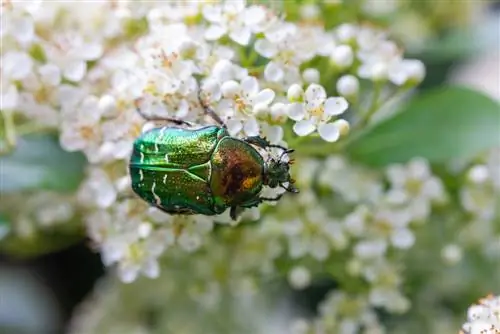
- There are around 3000 different species of rose beetles, most of which are native to the tropical regions of the world.
- They often attract attention with their shiny metallic colors and colorful patterns.
- Native species are useful in the garden because they contribute to humus production and pollinate flowering plants. Larvae found in the compost are mostly rose beetle grubs.
- Exotic species can be kept in terrariums and are popular and, depending on the variety, quite uncomplicated pets.
What are rose beetles?
Like the closely related May or June beetles, rose beetles (lat. Cetoniinae) belong to the scarab beetles (lat. Scarabaeidae). The family is distributed all over the world, with a large proportion of the approximately 3000 species native to tropical regions. In Germany, only the golden rose beetle (lat. Cetonia aurata, also "common rose beetle"), which is often found in the garden, the less common large rose beetle (lat. Protaetia speciosissima, also "great gold beetle") and the copper rose beetle (lat. Protaetia cuprea). The other European species are rather rare in this country.are at home in the Mediterranean region.
Great biodiversity
The approximately 3,000 different species of rose beetles are spread across 400 different genera. Of these, only 14 varieties are native to Europe; the rest of the heat-loving insects are found primarily in the tropics.
European rose beetles at a glance
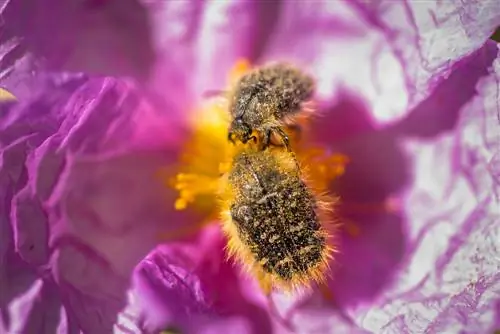
The black rose beetle is black unless it is full of yellow pollen
You can observe the rose beetles listed in the following table - with a bit of luck, as most species are considered to be critically endangered - in the garden or in the wild. The probability of this is particularly high in southern Germany - primarily Bavaria and Baden-Württemberg - as the animals are considered to love warmth. The list makes no claim to completeness.
| Art | Alternative names | Scientific name | Occurrences | Size | Coloring | Special features |
|---|---|---|---|---|---|---|
| Gold Shiny Rose Beetle | Common rose beetle | Cetonia aurata | all of Europe, Asia Minor and the Near East up to China | 14 to 20 millimeters | metallic green-gold shimmering | is protected in Germany |
| Mourning Rose Beetle | Black rose beetle | Oxythyrea funesta | mainly in the Mediterranean region, rarely in southern Germany | 8 to 12 millimeters | glossy black, lots of white spots/dots | critically endangered species |
| Large rose beetle | Big Gold Beetle | Protaetia speciosissima | Central Europe | 22 to 28 millimeters | metallic green-gold shimmering | critically endangered species |
| Copper Rose Beetle | Variable rose beetle | Protaetia cuprea | Central Europe | 14 to 23 millimeters | metallic green-gold shimmering | is protected in Germany |
| Bronze green rose beetle | Marbled Rose Beetle | Protaetia lugubris | Central Europe | 19 to 25 millimeters | shiny metallic with many white spots | critically endangered species |
| Shaggy rose beetle | - | Tropinota hirta | Southern and Central Europe | 8 to 11 millimeters | matt black, noticeable hair | endangered species |
Exotic rose beetles at a glance
Many of the rose beetle species known in this country come from Central Africa, where they occur primarily in the rainforests and tree-lined savannahs. Due to their size and colorful coloring, some of these varieties are very popular for keeping in terrariums, especially since this is considered to be quite uncomplicated. In the following table we introduce you to some of the most famous exotic rose beetles.
| Art | Scientific name | Occurrences | Size | Coloring | Food | Special features |
|---|---|---|---|---|---|---|
| African rose beetle (Uganda rose chafer) | Mecynorhina torquata ugandensis | Parts of Uganda and Congo | usually between 50 and 60 millimeters, sometimes significantly larger | very variable, multicolored | Imagines fruits, larvae humus | very common in terrarium keeping |
| Congo rose beetle | Pachnoda marginata | mainly Congo, but also other parts of Central Africa | 20 to 25 millimeters | variable, multicolored | Larvae feed on leaves and fruits | popular in terrarium keeping |
| Goliath Beetle | Goliathus | West and Central Africa | up to ten centimeters long, larvae up to 15 centimeters | striking black and white | Tree saps | are among the largest and heaviest beetles ever |
| South African fruit beetle | Pachnoda sinuata | South Africa and Namibia | 20 to 25 millimeters | striking black-yellow, yellow underside | Fruit and flowers | Classified as a pest in its homeland |
| - | Eudicella tetraspilota | Central Africa | 25 to 40 millimeters | variable, multicolored | Fruit | popular in terrarium keeping |
Characteristic features
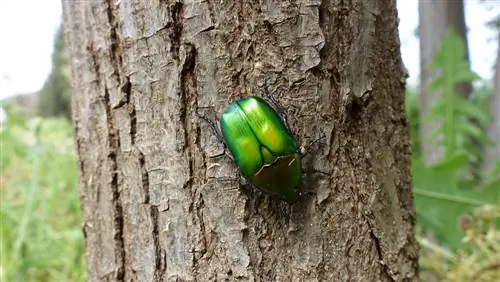
The rose beetle is so popular because of its metallic colors
Typical for most rose beetles is their magnificent coloring, which is why some species are often kept as pets in terrariums. The animals are often shiny metallic or otherwise strikingly colored, and, rather unusually for beetles, they also have a second pair of wings. They can unfold this through a curvature under the closed wings and fly. This makes the animals appear somewhat clumsy and clumsy. The larvae of rose beetles are typically curved in a C-shape, typical of grubs, and only stretch out when lying on their backs. Incidentally, grubs are not only the larvae of May and June beetles, but also the offspring of all scarab beetles in general.
Lifestyle
The adult rose beetles - called adults - feed mainly on liquid leaf and tree juices as well as flower nectar and fruit. Some varieties even eat entire flowers and are therefore classified as pests. A typical example of this is the South African fruit beetle. The larvae usually live in rotting wood or sludge and feed on it. However, the specific way of life of the beetles is highly species-dependent and therefore variable.
Rose beetle in the garden
Have you found a golden rose chafer in your garden? Then it is most likely the common or golden rose beetle (lat. Cetonia aurata), which is quite common during the summer months. Since this species, like all rose beetles, loves warmth, you can find the animals especially during the midday hours on roses and other large-flowered plants such as:
- elderberry
- Dogwood
- Hawthorn
- Fruit trees
- Umbelliferous plants
The larvae, on the other hand, feel particularly comfortable in the compost, as they find plenty of food here. In the wild, however, offspring tend to grow and thrive in rotting wood, for example at the foot of large and old trees.
Pest or beneficial insect?
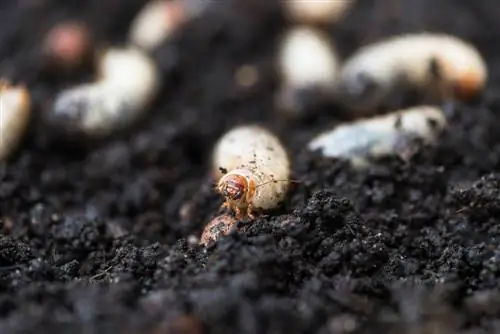
Rose beetle larvae look very similar to the dreaded grubs
Many gardeners carelessly destroy the rose beetle grubs found when digging up the compost. No wonder, after all, the white larvae can easily be confused with those of the May, June or even the garden leaf beetle. In contrast to these species of scarab beetles, neither the larvae nor the adult rose beetles are pests - quite the opposite.
While the rose beetle larvae live primarily on the rotting organic components of the compost during their approximately two-year larval period and thus make an important contribution to converting it into valuable humus, the adult beetles feed mainly on pollen and nectar. Since they prefer liquid food, plant juices (which can be used for cuts, etc.) can also be used.arise) or the juices of ripe fruits are on the menu.
Eating damage in the form of nibbled petals and other plant parts, however, is not to be feared - unless the population becomes so overwhelming that the available food is not enough for all rose beetles and their larvae. However, this is only very rarely the case, for example when the grubs develop in a small flower pot. Here the rose beetle larvae sometimes eat the roots out of sheer hunger, but such behavior is not normal.
The meaning of the rose beetle and its larvae at a glance:
- neither adult beetles nor larvae eat parts of plants
- Larvae do not feed on roots and other underground parts of plants
- adult rose beetles need liquid food such as pollen and nectar
- Larvae feed on decaying organic matter
- Rose beetles, on the other hand, help pollinate plants
- Larvae are important for humus formation
Because of these important roles for the ecosystem, the rose beetle was voted “Insect of the Year” in 2000. The fact that the pretty animals are also considered an endangered species probably also played a significant role in the decision. For all reasons nothing has changed to this day.
Excursus
Rose beetles are under nature protection
In contrast to the other rose beetle species, the golden rose beetle is not considered to be in acute danger of extinction, but is still subject to the Federal Nature Conservation Act and is therefore considered a particularly protected species. This in turn means that you neither the adult beetles nor its larvae allowed to catch, collect or even kill. Therefore, when you find grubs, check carefully what species they are.
Rose beetle larvae in compost
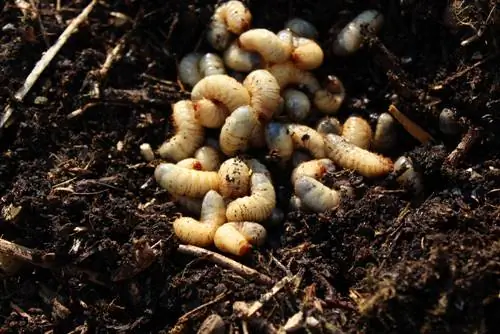
Rose beetle larvae are a blessing for any compost
If you find grubs in the compost, they are almost always the beneficial larvae of the rose beetle. Be sure to bury them again as quickly as possible because they die quickly in the sun or air. The larvae of the May beetle, on the other hand, can be found where the table is richly covered with plant roots - this is what these little animals feed on, which is why - in contrast to the rose beetle grubs - they can cause considerable damage in the garden. You will almost never find May beetle or June beetle larvae in the compost because there is a lack of their favorite food, living plant roots.
Rose beetle or cockchafer larva? How to distinguish the grubs
Rose and cockchafer larvae look quite similar on the outside, but they can be easily distinguished from each other based on certain external characteristics and their method of locomotion. For this locomotion test, it is best to place the larvae found on a flat surface.
| rose beetle | Cockchafer | June beetle | |
|---|---|---|---|
| Body length | 5 to 7 centimeters | 5 to 7 centimeters | 5 to 7 centimeters |
| Body shape | thicker at the back than at the front, weak stubby legs | evenly thick, strong, longer legs | evenly thick |
| Coloring | white, gray-black shades | white-yellowish body, brown head | white-yellowish body, brown head |
| Locomotion | stretches up, stubby legs, crawls away on his back | stays crooked on its side and tries to crawl away | stretches, crawls in prone position |
By the way: Even if the larvae of May and June beetles are pests, these species have now become very rare. In the meantime, the two species were considered almost extinct, but populations appear to be gradually recovering. Therefore, if possible, do not kill the larvae, but perhaps just dig them up and rebury them in another place. By the way, neither the May beetle nor the June beetle are protected.
Tip
If the larvae found in the compost are particularly large specimens, you have probably discovered larvae of the rare rhinoceros beetle (Latin: Oryctes nasicornis). These often grow to be more than seven centimeters long and are also among the humus-producing beneficial organisms.
Development and life expectancy
Depending on the weather, the rose beetles' flight period begins in April. At this time the brummers come out of their winter quarters. The females soon begin laying eggs, for which they look for a suitable spot in a compost heap or on decaying wood. The spherical, small eggs are whitish in color. The larvae hatch after just a few days.
- Larval development takes place over a period of two to three years.
- The larvae grow up to approx. five centimeters long.
- They shed their skin twice.
- They feed on decomposing, organic material such as wood residues, fruits, sludge, etc.
- At the time of pupation, the larvae build cocoons out of earth, sand and wood scraps.
- Pupation takes around three weeks, then the finished beetle hatches.
- Pupation usually occurs in late summer / early autumn.
- The young, newly hatched beetles overwinter in the ground.
- They only appear in spring.
From this point on, the finished beetle will live for about five to seven months, provided it has not previously fallen victim to an accident, illness or a predator (e.g. a songbird). However, the animal does not hibernate once again, but dies in autumn at the latest.
Fighting rose beetles? This is what you can do
Since the rose beetle is a protected species and is also very useful in the garden, you are not allowed to fight it. Neither biological nor chemical or even home remedies are permitted as measures. However, if the animals feel too comfortable in your garden and multiply excessively, you can make it uncomfortable for them with a few simple measures:
- Keep the compost under lock and key, especially during egg-laying season in spring.
- Always clear away rotting wood and other dead wood in the area.
- Collect adult beetles and release them elsewhere.
- The best time for this is early in the morning, as the beetles here are still quite sluggish and barely able to move.
- Dig up the larvae and release them in another suitable location.
But as already said: Strictly speaking, these measures are not necessary because it is a very beneficial insect.
Rose beetle larvae in flower pots - How to save your potted plants
It only becomes problematic when the larvae have nested in a flower pot. In such a case, things can quickly become too crowded and, above all, there will be a shortage of food, which is why the grubs - completely against their nature - also eat living plant roots. But that doesn't have to be the case:
- Lift the plant and its root ball out of the pot.
- Carefully collect all the grubs.
- They do not bite and are not poisonous.
- First place them in another pot filled with soil.
- Bury the larvae back in a suitable location as quickly as possible.
- Clean the planter and reinsert your plant into a fresh substrate.
Do not leave the larvae without protection for too long, as they only survive for a very short time in the sun. A suitable new home should be rich in humus and decaying plant residues. Garden compost is ideal for this purpose.
Keeping and breeding rose beetles

Rose beetles can be grown at home
Due to their dazzling colors, rose beetles are popular pets that are great to keep in terrariums. Sufficiently large plastic boxes from the hardware store are suitable for this, as are high-quality housings made of glass, for example. The only important thing is that the containers can be ventilated, and the temperature and humidity must also be able to be regulated. For smaller beetle species, the terrarium should have an edge length of 30 centimeters; for larger ones, 50 centimeters is optimal. Also, do not keep the animals alone, but always with at least two people.
Rose beetles are very short-lived pets: the adult beetles do not live longer than about five to seven months. In order for you to benefit from your new favorites, you must ensure the appropriate breeding conditions in the terrarium. Then your females lay eggs and you can continually enjoy new animals and closely observe them throughout their entire development period. But be careful: rose beetles don't like being taken out of the terrarium and held in your hand. They don't become tame, just stressed - which in turn has a negative impact on their life expectancy. If you're looking for a cuddly toy, you'd better get a rabbit or a guinea pig.
Suitable species
Many rose beetle species are suitable for keeping in terrariums, but not all of them are suitable for beginners. Some species are quite demanding, which is why you need not only sensitivity but also a certain amount of experience and specialist knowledge. The species Goliathus (Goliath beetle), Argyrophegges (also a giant beetle from the group of Goliath beetles), Fornasinius (a black Goliath beetle) and Hegemus (a black Goliath beetle) are considered particularly difficult to keep and breed with nice drawing).
However, these types are best suited for beginners:
- Pachnoda marginata peregrina: Congo rose beetle, classic in terrarium keeping, needs temperatures between 23 and 27 °C, a bright location and lighting, substrate height 15 centimeters, deciduous forest humus with rotting Whitewood
- Chlorocala africana: optimal temperature between 25 to 30 °C, not less than 18 °C at night, high humidity between 70 and 75% (80 to 85% at night), 15 centimeter thick substrate layer made of leaf humus (oak, beech) and rotting wood
- Dicronorhina derbyana: optimal temperature between 18 and 25 °C, 15 centimeter thick substrate layer of deciduous forest humus
- Eudicella euthalia bertherandi: Brown rose beetle, optimal temperature between 18 and 25 °C, humidity between 60 and 80%, 15 centimeter thick substrate layer of deciduous forest humus
The rose beetles listed here are all diurnal and are therefore suitable as pets.
Where can you buy rose chafers?
If you are interested in keeping and breeding rose beetles, you will find corresponding offers in specialized pet shops. However, you probably won't be able to find what you're looking for at the specialist shop around the corner or you'll have to order the animals you want there. Purchasing from online retailers is easier, but you should definitely choose reputable offers. For example, they do not send the animals all year round, but only when the weather is right (i.e. not when it is very hot or cold!) and also mark this in their online shops.
Make sure you are home when you receive the package so that the animals don't have to spend days unnecessarily in the mailbox or in the neighbors' packaging. The travel container is not designed for this and may cause your new pets to die. As a rule, you can purchase both adult beetles (price around 20 EUR each) or larvae (five pieces around 25 EUR).
Terrarium: Rose beetles feel comfortable with this facility
Setting up the beetle terrarium is quite uncomplicated: the most important thing is the approximately 15 centimeter thick soil layer made of leaf humus and rotting wood. Depending on the type, it is best to use substrate that has already been mixed by the dealer or mix it yourself
- Foliage of forest trees (beech, oak)
- Leaf humus (bought or from the forest)
- Sand
- and chopped branches (beech, oak)
The substrate should - depending on the type of beetle - be moist to rather dry, but in no case bone dry. Put a few more branches in there for the adult beetles to climb on. However, how you further design the interior is entirely up to you and your taste. However, various stones (in groups, as hiding places) as well as plants with typical food plants are perfect.
Tip
If possible, avoid using heating mats to heat the terrarium, as these allow the substrate to dry out and thus disrupt the development of the larvae.
What food do rose beetles need?
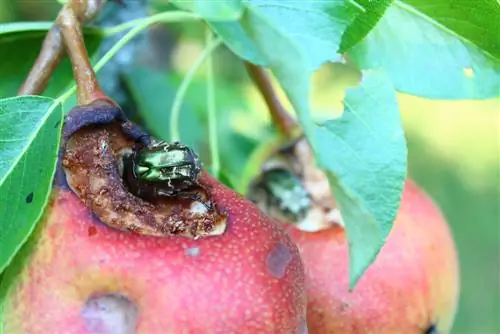
Rose beetles love fruit
Rose beetles are pure vegetarians. Either feed the adult beetles with so-called Beetle Jellys (available from specialist retailers) or place ripe to overripe fruit on a flat dish in the terrarium. The animals particularly like to eat bananas, pears, strawberries and mangoes. Colorful flowers that you can pick fresh and give to the animals provide more variety. The rose beetles often sit for hours on hibiscus, pumpkin and zucchini flowers, but also on nasturtiums, clover, dandelions and fruit tree blossoms and enjoy pollen and nectar. The larvae are fed special larval food and overripe bananas.
Frequently asked questions
Are rose beetles poisonous? Are they dangerous for small children and pets?
No, rose beetles are not poisonous. Since they are neither poisonous nor bite or sting, they are completely harmless to both children and many pets. So don't worry if your cat or dog has eaten such a beetle. By the way: In many regions of West and Central Africa, the larvae of the Goliath beetle, which are around 15 centimeters long, are considered a delicacy and are also an important source of protein there.
Can the rose beetle fly? When are the animals particularly common?
The native rose beetle species fly between April and October, but are particularly common in the warm summer months - and especially at lunchtime. In fact, the fat beetles can fly, but they keep their cover wings closed and simply push out the pairs of wings underneath.
Tip
Rose beetles usually pupate in late summer and overwinter as finished beetles in the ground. The same applies to the larvae, which also do not leave the protective earth.

